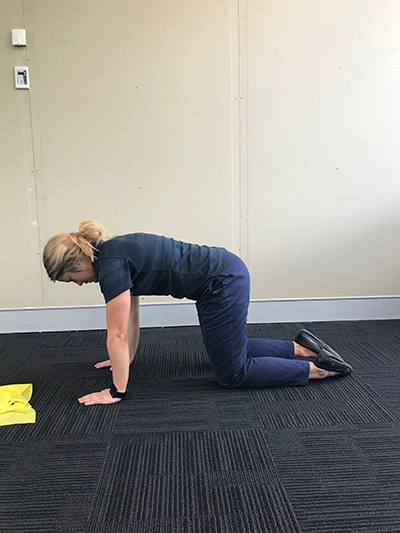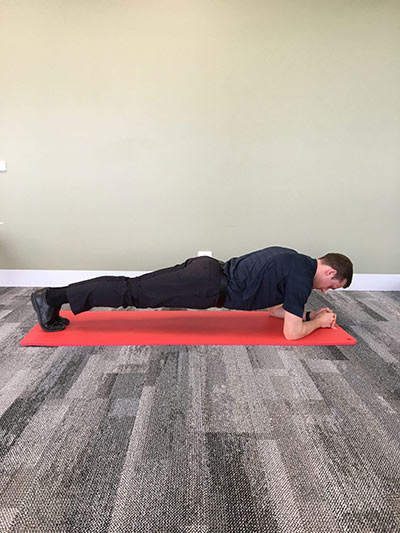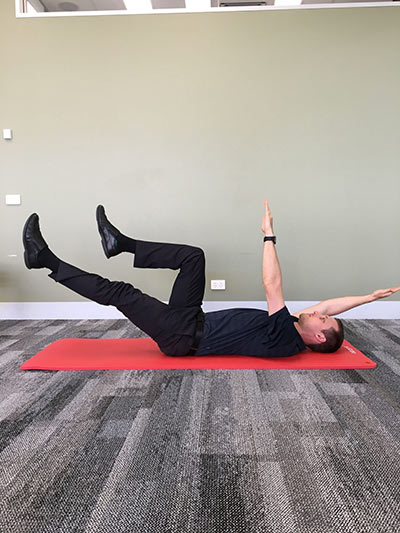Top 5 core exercises for horse riders for better riding and less injury!
Learn the top core exercises for horse riders. Horse riders often focus more on the movement of their horse and forget about their riding position. Your core is important because your riding position impacts on your own body, the forces going through the saddle, and the movement of the horse. Here at Sport and Spinal we can assist with your riding position and help you avoid long-term injury.
The ultimate riding position
Here is a simple guide for the ultimate horse riding position for flat ground general riding
- Stirrup length – for flat riding the stirrup iron should sit just higher than the ankle bone when the foot is out of the stirrup and the leg is relaxed. When the foot is in the stirrup let your weight sink into the heels.
- Leg contact – ensure even contact of lower leg, inner knee and thigh on the horse
- Hip position- Sit on top of your seat bones and imagine them melting away from each other. This is to keep the pelvis neutral, and to help stop the bottom muscles clenching.
- Lower limb alignment- ensure there is a vertical line from the hips to the heels.
- Upper body alignment – lift tall through the front of the chest and imagine there is a piece of string pulling you from the top of your helmet to the sky.
- Arm position- hand placement should be slightly in front of the withers and approximately 2-3 inches apart. Keep the hands closed around the reins but relaxed.
Core exercises for horse riders
A strong core is important for horse riders. It helps provide shock absorption, keeps your riding position symmetrical and balanced, and allows better control during more difficult maneuvers such as pivots.
A lack of core stability results in excessive movement in the saddle, which can interfere with the communication to your horse. In addition, an unbalanced position leads to asymmetry in the saddle, and places unfavourable loads through the body. This can lead to musculoskeletal pain, such as low back pain, and stiffness. Horse riding and horse training is considered ambidextrous, however, research has shown that riders are at risk of developing acquired asymmetry in the body due to a range of anatomical and functional differences between the left and right side of the body. These differences are exacerbated with repetition and/or pain avoidance.
A study by Alexandra Hampson demonstrated that an 8 week core strengthening program improved rider symmetry during the sit trot, and increased stride length of the horse. Although this study shows the value of core strength, there were some limitations affecting the quality of the study. These limitations include:
- Small sample size
- No Long term follow up after the 8 weeks
- Heterogeneity between riders, saddles used and horses
What is the core?
The core is a combination of three body systems that work interdependently to stabilise the spine. In 1992, a professor referred to as Panjabi created a convenient model to describe the core.
The core composes of:
- Active subsystems which involve the muscles (muscles create movement)
- Passive subsystems which involve the bones and ligaments (ligaments act to stabilise)
- Neural subsystems which involve the central nervous system (brain and spinal cord), spinal nerves and receptors. These receptors are located in the muscles, tendons, bones and ligaments. The neural subsystem receives incoming information from the receptors, and responds by sending output to the muscles thus creating movement.
Let’s look at the core and the active subsystem
Today we will focus on the active subsystem, the muscles of the core.
Our core muscles are divided into two categories:
- Local muscles
- Global muscles
The muscles for core exercises for horse riders
Our local muscles are shorter, and located deeper and closer to the skeleton. They contain slow twitch muscle fibres, which are recruited for low impact and long lasting activities. These muscles, including the transverse abdominis (a deep core muscle), are recruited for many of our normal activities to provide segmental stability of the spine.
Did you know, that when you lift your arm in the air, your transverse abdominis muscle will contract before your arm is lifted. However, in the presence of pain and injury, these muscles can be inhibited and consequently decrease in size/shape at the location of injury. This places more stress over the area of pain (Hodges and Richardson 1997).
The local muscles can be thought of as a wooden barrel. The pelvic floor forms the base, the deep spinal and abdominal muscles form the sides, and the diaphragm forms the roof.
Our global muscles are located more superficial in the body. They contain fast twitch muscle fibres, therefore are recruited for shorter activities and requiring a greater force. For example, during a bicep curl.
Why is our core and core exercises important?
Our core is important because it creates a foundation for the movement of our limbs and to maintain posture. Poor control of the core results in suboptimal loading through the spine and unfavourable changes to our movement patterns. In turn, these altered movement patterns can lead to pain and injury.
How do we train the core with core exercises?
Core stability is trained in a progressive manner. It starts with learning the skill of co-contracting the local muscles. The next stage is then challenging this recruitment in different body positions with minimal activation from the global muscles. Finally this is integrated into functional activities involving the global muscles.
Here is an example of an exercise progression for deep core training
1.Abdominal hollowing
Imagine there is a bucket of water sitting on your pelvis. Rock the bucket towards and away from you. Then find the mid point where the bucket of water is not spilling any water. This is referred to as a neutral spine position. Hold this position, and practice breathing in through the nose and out through the mouth.
2. Four Point Kneeling
Come onto your hands and knees. Ensure the wrists are sitting under the shoulder, and the knees are under the hips.
3. Toe Taps
Find your neutral spine position, then lift one leg at a time to a table top. Ensure the knees are inline with the hips. Keep the knees bent at 90 degrees. Slowly lower one leg at a time to the floor, like you are dipping the toe in a bucket of water. Then return to the starting position.
4. Lifting
Stand with your feet approximately hip width to create a stable base of support. As you lower towards the level of the object, bend your knees and keep your chest tall. Remember to keep the object close to your centre of gravity as you lift. If you need to turn while holding the object, pivot your feet around to avoid twisting through the trunk.
)
Top 5 core exercises for horse riders
Training the core muscles for spinal stability is not warranted for everyone, even those with back pain. Research has shown that exercises for core stability is more effective for those with a weak core, poor posture, and altered movement patterns. At Sport and Spinal, our physiotherapists will undertake an assessment of your core stability to determine the best pathway for you.
Now that we understand what the core is, its importance and how to train it. Here are the top 5 core exercises for horse riders.
1. Plank holds
Place the hands under the shoulders, just slightly more than shoulder width apart. If you experience wrist pain, then come onto the elbows and forearms. Keep your body straight from the heels to the head.
2. Dead bugs
Bend both hips to 90 deg. Then extend opposite arm to leg, then return to the starting position and repeat to the other side. Remember to maintain a neutral spine position.
3. Single arm and leg reach
Slowly extend opposite arm to leg off the ground. Keep the hips still and only lift the leg to hip height, and the arm to shoulder height. Return back to the starting position and repeat to the other side.
4. Roll Downs
Imagine you are standing against a brick wall with the feet hip width apart and the knees relaxed. Bring the chin to the chest, then roll down, peeling your back off the imaginary brick wall. Let your arms and head feel heavy. Hold at the end for 5-10 seconds, then slowly roll back up to the starting position.


5. Swimming
Lie on your stomach with the forehead on the ground and the belly button lifted towards the spine. Extend opposite arm to leg, lifting off the floor and imagine drawing the shoulder blade to the opposite hip. Alternate between sides. Start slowly and gradually increase the speed.
Reference List
- www.researchgate.net/publication/319108110_The_influence_of_an_8-week_rider_core_fitness_program_on_the_equine_back_at_sitting_trot
- www.ncbi.nlm.nih.gov/pubmed/1490034
- www.ncbi.nlm.nih.gov/pubmed/9037214
- www.ncbi.nlm.nih.gov/pmc/articles/PMC4234750/
- www.horsejournals.com/riding-training/english/hunter-jumper/develop-stronger-riding-position









